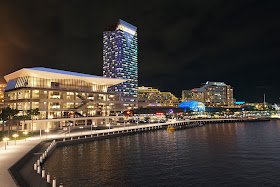A building boom is set to change the face of Australia’s hotel industry, with some 120 hotel projects in the pipeline which will grow accommodation availablity by 30% between 2016 and 2021.
This year saw Australia pass the 100,000 room mark and it is forecast that over 4000 rooms will be added in 2017, and 5000 rooms in 2018, giving every capital city across the country new properties ranging from 500+-room internationally branded luxury properties to intimate boutique hotels.
 |
| Sofitel Sydney Darling Harbour |
To overcome the lack of land in cities and high cost of construction, hotel developers have become savvy, often converting existing buildings to hotel use. For instance, the stylish QT Hotel in Melbourne was created out of the owner’s Greater Union cinemas on Russell Street, while the art-deco Metropolitan Water and Sewerage Board building in Sydney’s Pitt Street now has a far more salubrious role as the city’s newest five-star hotel, the excellent Primus.
The last time Australia saw such increases in hotel accommodation was prior to the 2000 Olympics, when there was growth of 7,500 rooms between 1998 and 2000, but the room boom was followed by a dramatic bust, with faltering international and domestic economic conditions, wars and airline collapses contributing to the downturn.
On this occasion, Australia’s peak accommodation body, Tourism Accommodation Australia (TAA) believes that a unique combination of circumstances will not only soak up the supply but enable Australia to attract a vast new audience of high-end tourists, business travellers, and conference and incentive groups.
The chair of TAA, Martin Ferguson, was Minister for Tourism in 2010 when he announced Australia’s Tourism 2020 goals. The addition of 40,000 new rooms over the decade was identified as a crucial ingredient in achieving the targets set for the industry.
“We recognised at the start of the decade that we needed to significantly revitalise and rejuvenate the tourism industry’s infrastructure and upgrading hotel stock was a key priority,” Ferguson said.
“With almost double-digit growth in visitor arrivals – particularly from China – we are well on the way to achieving our visitor targets, and this growth will be sustainable in the long term with such high-quality new accommodation being added across the country, complemented by major infrastructure projects such as airports, convention centres and urban redevelopment.”
Tasmania has enjoyed some of the strongest increases in leisure travel in recent years, built on what is being termed the ‘MONA effect’ – the influence of the uber-trendy Museum of Old and New Art. Such has been in its impact on tourism that owner David Walsh has proposed a new 160-room hotel cheekily dubbed HOtelMOna, which would also contain a function centre and spa.
A focal point for the dramatic hotel growth is Darling Harbour in Sydney, where one of the largest new hotel developments in over 20 years – the Sofitel Sydney Darling Harbour – will open in the final quarter of 2017, while the $700 million Ribbon Hotel and Residences project (which will include a W Hotel) is under construction on the former IMAX site.
On the city side of Darling Harbour, Australia’s largest hotel – the Four Points by Sheraton – is adding 222 rooms to increase its inventory to 892 rooms, while also rebranding to Hyatt Regency.

No comments:
Post a Comment